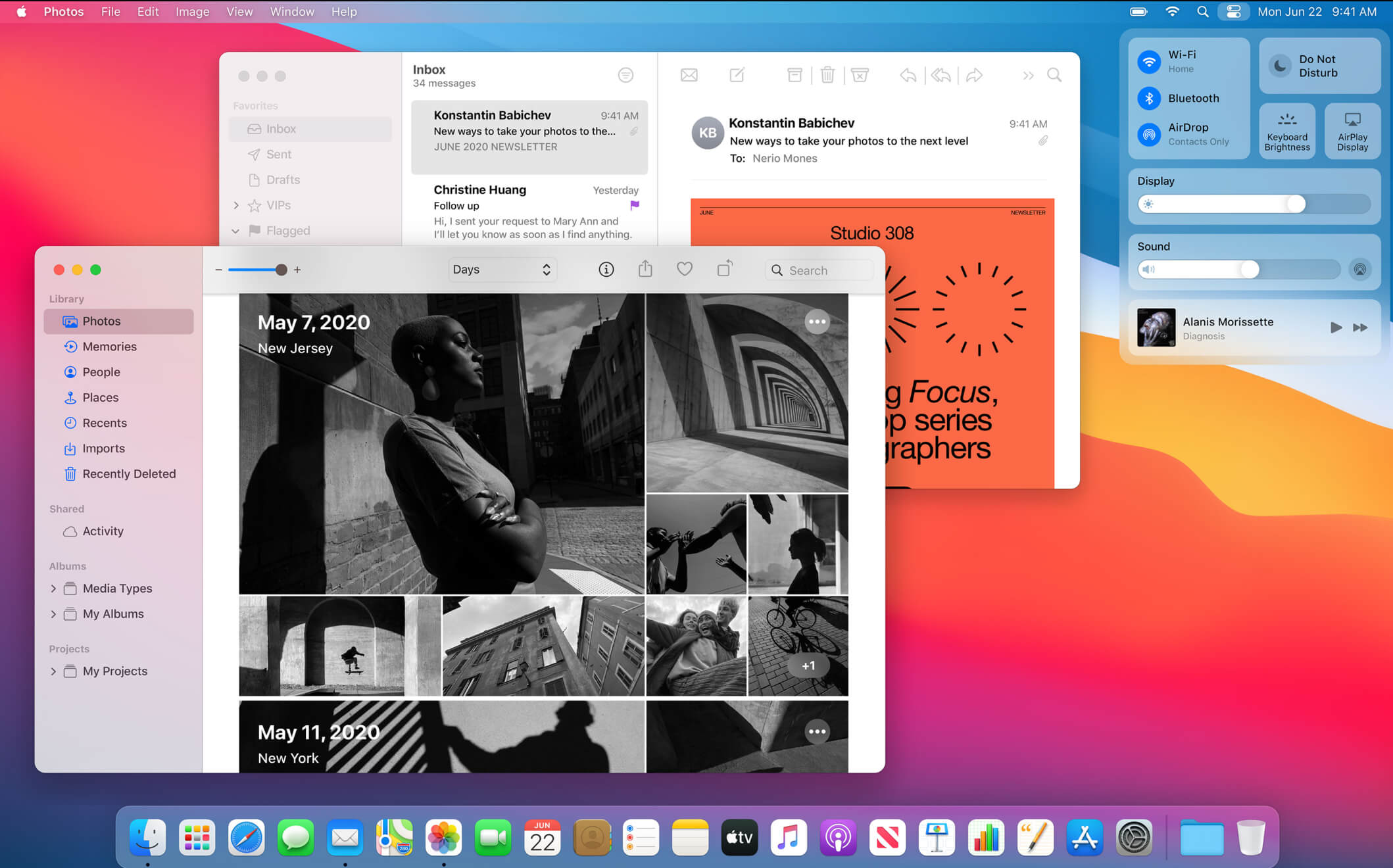Macos Big Sur Dosdude1

How to Install macOS Big Sur on Unsupported Mac mini Booting the macOS Installer Once you finish setting up setvars EFI utility, you're ready to install macOS Big Sur on your Mac mini. Start your Mac mini and while restarting, hold down the option key and boot from 'Install macOS Big Sur'. The installer will load in a while.
macOS 10.14 Mojave is one of the most highly lauded desktop operating systems developed by Apple, Inc. It comes with a slew of new features and enhancements that's geared towards a smoother and more delightful user experience. If you haven't upgraded yet, we'll show you all the possible ways to download macOS Mojave so you can create a bootable macOS USB for installation and start to enjoy the benefits that millions of other users around the world are already seeing from this upgrade, such as Dark Mode, Continuity Camera, Stacks and the Voice Memos app.
Sometimes, Apple will update versions of macOS that fall outside of the two-year cutoff. In November of 2020, Apple issued a security update for macOS High Sierra, even though it was three versions behind the latest release (Big Sur) at the time. We talk about a lot of new version of macOS, like Big Sur or Catalina, which is now packed with many amazing features. However, they need to more advanced hardware to run the OS smoothly. If you are using an old model of Mac computer, High Sierra is still the best choice if it was not eligible for upgrading to Catalina or Big Sur. I recently switched from manjaro linux to macos catalina on a mid 2009 macbook pro. If Big Sur is a no-go for non-Metal macs, linux kernel 4.19 LTS would be the next best option from 2022 (projected end of catalina support) to 2024 (projected end of 4.19 LTS support). Edit: All kernels 5.x have wake from suspend issues with the mid 2009 macbook.
Downloading macOS Mojave can get a little confusing because there are two types of downloads. One is the basic stub installer file that's about 22-23 MB, but the full size installer is about 5.8 to 6 GB. The stub installer does fetch all the other required content once you do the installation, but if you need the full installer so you can put Mojave on a different computer, then there are several ways to do that.
macOS Mojave DMG Direct Download Link
The legit way to download or install macOS Mojave provided by Apple is through Mac App Store, where you can get the macOS Mojave install app but it is can be used by other programs for installation. You need addtional settings to make it work. However, some of the tech experts are smart enough and grab the direct download link of macOS Mojave.
macOS 10.14.1 DMG Direct Download Link 1: https://archive.org/download/macOS_Mojave.dmg
macOS 10.14.1 DMG Direct Download Link 2: https://sundryfiles.com/9tz
macOS 10.14.1 ISO Direct Download link (for Windows PC User): https://ia600701.us.archive.org/28/items/MacOSMojave10.14.iso
In addition, you can also download the install dmg from other file hosting or torrent sites. This method is a little risky unless you know the website you're downloading from. For example, some websites that offer direct downloads for macOS Mojave will actually give you version 10.14.1, which is an update rather than the full OS installer. Others might even just serve you the stub installer.
To avoid this, try and read some genuine user reviews before attempting this approach. For that reason, there's no particular site that we recommend. However, that's not to say that there aren't genuine sites that offer the full installer. Most are free, but some might ask for donations via PayPal. If their version works out for you, it's up to you whether you want to pay them a small amount for their trouble.
p.s you need to burn mojave dmg to USB to make it a bootable media for macOS installation. After that, you can use the bootable USB to install macOS on the current or another Mac.
Use Download Manager to Get Mojave DMG Installer
macOS Mojave Patcher is a third-party utility that can be downloaded from the dosdude1 website, and is required to get the full 6GB DMG installer file for macOS Mojave.
As a first step, download the patch utility and run it on a Mac PC or laptop. Note that some Mac computers are not supported by this software, so check the list of compatible devices before getting the app. Within the app, click on the Tools option in the top toolbar and select Download macOS Mojave… The keyboard shortcut for this is Command+D. You'll see a pop-up notification asking you to confirm the download. Click Yes to download the full installer, which should be around 6000MB.
Download macOS Mojave DMG Installer from Mac App Store
If all you need is the stub installer for an upgrade from an existing macOS installation, it's even easier because it's just a question of simple and direct download from Apple's servers. However, this version can't be used for a clean install on a different computer because it won't contain the needed applications to create bootable media on a USB or DVD. For that, you are better off using the first method.
Go to App Store app on your Mac and search for macOS Mojave, then click the Get button next to it. This file will be called Install macOS Mojave.app, and all you need to do is click the Download button in the Software Update utilitiy that automatically launches when you click on Get in the App Store. You will need to enter your Mac credentials when prompted.
Again, remember that this is merely the stub installer, so it's only useful for upgrading current macOS to Mojave, not able to do a clean install on a different computer.
Re-Download Mojave with Mojave Running
Another way to get the stub installer is when you're already running macOS Mojave on your computer. The process is the same as the one described in Method 2, so you can follow the steps described above.
In certain cases, however, this method won't work because the Get button might not be available. It might show you that the OS is already installed, which means the button is greyed out and basically useless to you.
Abort the Reboot after Running macOS Mojave.app
This method is a sort of gimmick that tricks the stub installer into downloading all the required files for a full installation, and then aborting the process right before your computer reboots to actually go into the installation. This is not for the feint-of-heart because it requires commands to be run in Terminal, the command line interface in Mac.

Get the stub installer from the App Store and run it. You'll see several prompts, which you just need to follow by clicking through each. When you see the countdown timer for the reboot, hit the Cancel button.
At this point, all the files for the full installer have been downloaded, but they still need to be packaged in order to work. For this, run the following three commands in Terminal (Applications > Utilities), clicking Enter after each one:
sudo -s
mkdir /Applications/Install macOS Mojave.app/Contents/SharedSupport
cd /macOS Install Data
find . -mount | cpio -pvdm /Applications/Install macOS Mojave.app/Contents/SharedSupport
Now go to the directory where you saved the original stub installer, and you'll see that it has magically turned into a 6GB file, which is the full installer.
Summary
These are all the possible ways to download macOS Mojave to your computer so you can create bootable media for a macOS installation. If you're aware of other methods or genuine sites for downloading the full DMG file from macOS Mojave 10.14, please do share it with our readers in the comments section.
This page describes macOS 11.0 (Big Sur) specific information.
If you have previous macOS version please refer to previous macOS SIP instructions.
You might want to read this blog post for historical context.
TotalFinder is not compatible with Apple's latest computers with M1 chip. It fails by reporting that Apple events cannot be delivered. Unfortunately there is no known solution at this point. Please subscribe to this forum thread for further updates.
TotalFinder has support for macOS 11.0 (Big Sur), but cannot run on a normally configured machine due to System Integrity Protection (SIP). This article can help you how to configure your machine to allow TotalFiner installation by modifying security setting.
If you decide to modify the settings, you will be able to install TotalFinder. Just to be clear…
Your machine may be less secure when you disable extra security features. It is entirely your decision to modify the settings.
What is different in macOS 11.0 (Big Sur)?
Mac Os Big Sur Dosdude1
The Finder binary is newly marked as a “platform binary”. That means that system prevents injecting or loading any code which is not signed by Apple developers. This feature is called “Library Validation” and was first introduced in macOS 10.10 (Yosemite). Finder didn’t participate in this prior macOS 11.0.
Currently in beta macOS 11.0 users can disable Library Validation using this command in Terminal.app:

This will allow injection of TotalFinder code in Finder. But please note that Library Validation is disabled system-wide. So any app which relied on Library Validation might be less secure.
How to install TotalFinder by turning off System Integrity Protection
TotalFinder will guide you through the process via notification dialogs. Please check the TotalFinder installation page for general installation steps. This document explains SIP-specific steps.
You must boot into the Recovery OS. You do this by restarting your machine, and holding Command+R until the Apple logo appears. Then select Terminal from the Utilities menu. It looks like this:
Macos Big Sur Patcher Dosdude1
In the window that opens, type csrutil disable and press return. This turns off System Integrity Protection so that TotalFinder can be installed.
Reboot your machine and you may install and run the latest version of TotalFinder.
Unfortunately you have to keep SIP disabled to allow TotalFinder. In earlier macOS versions it was possible to turn SIP off only to complete TotalFinder installation steps and enable it back again. That is no longer possible in recent macOS releases due to hardened security settings.

Dosdude1 Macos Big Sur
Technical details
TotalFinder works by altering the built-in system application Finder.app.
In order to change some features of Finder, we use a technique called code injection. This means we add some additional code to the Finder program whilst it is running to do what we need. This is relatively safe - in fact we do not change any part of macOS on the disk. You only have to quit Finder via Command+Option+Esc, and the Finder will restart and everything will be as if TotalFinder was never running.
However, in macOS 10.11 (El Capitan) and later the macOS developers added a feature that disallows this kind of modification even if you have administrator access. It will also disallow other kinds of modifications (such as replacing parts of the system on disk).
Uninstallation and SIP
To remove TotalFinder from your system, run the uninstaller found on the latest dmg download of TotalFinder.